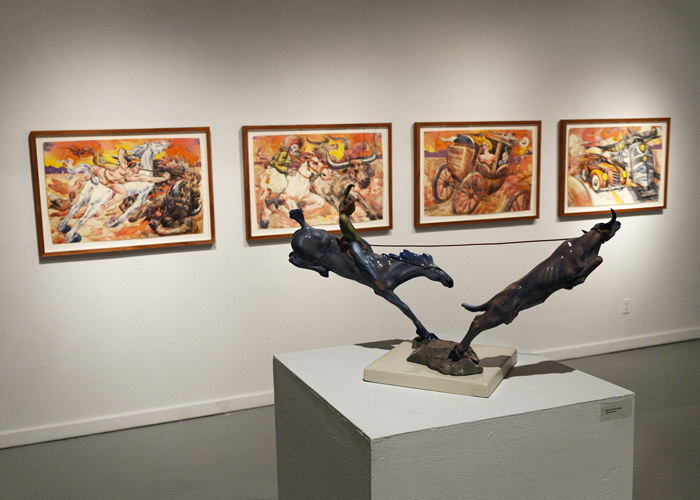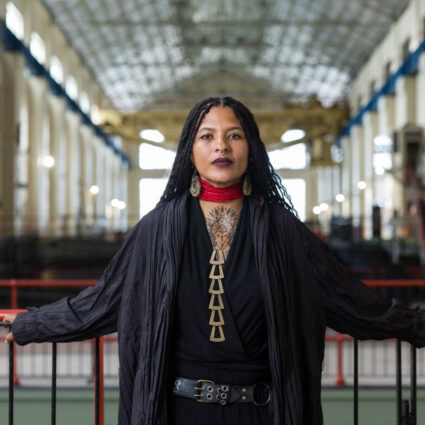Luis Jiménez’s monumental sculptures are found all over the country. Why is the artist not more well-known?
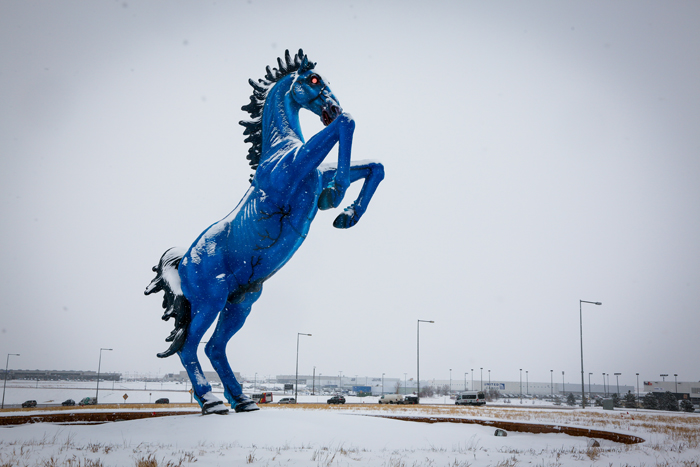
You can’t miss it: the terrifying, intensely blue, rearing mustang sculpture with glowing, demonic red eyes situated outside of Denver International Airport. At thirty-two feet and 9,000 pounds, it was the artist’s largest sculpture, and also his last.
In 2006, a part of the sculpture swung loose from a hoist in the artist’s studio, severing an artery in his leg and leading to his tragic death. Commissioned in 1992, before DIA even opened, the sculpture Mesteño/Mustang by Luis Jiménez was finished posthumously by the artist’s family and installed in 2008. Described by one travel writer as “one of the city’s more alarming public artworks,” the mustang is a striking sight, as are all of Jiménez’s wild-eyed sculptures.
Jiménez’s most prominent works may be his large-scale public art commissions, scattered across the country: like his gun-slinging, bucking Vaquero (modeled 1980/cast 1990) situated in front of the Smithsonian American Art Museum in Washington, D.C., or Southwest Pietà (1984) in Albuquerque’s Martineztown neighborhood.
I had seen Jiménez’s garish Fiesta Dancers (Fiesta Jarabe, 1991-97) in front of the Colorado Springs Fine Art Center many times before connecting it to the artist who made Mustang. It was in Roswell, however, where I encountered, for the first time, a critical mass of Jiménez’s work that made me realize what a staggeringly unique artist he was.
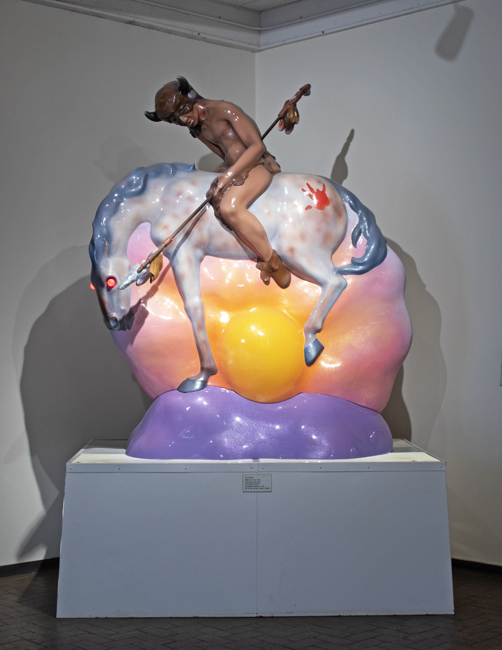
Both the Roswell Museum and the Anderson Museum own monumental sculptures by Jiménez that astound with their dynamism, movement, and energy. With lightbulb eyes and candy-colored automotive paint, the fiberglass sculptures bulge with muscle—like carnival kiddie rides on steroids.
The son of an undocumented Mexican immigrant, Luis Jiménez was born in El Paso in 1940 and spent formative years working in his father’s sign shop, learning to use industrial materials like neon and fiberglass. Immersed in car culture as a teenager, he spray-painted hot rods before receiving his degree in fine arts from the University of Texas at Austin in 1964. Early on, he decided to work with industrial materials, rather than more traditional fine-art media. “I wanted a material that didn’t carry the cultural baggage of marble or bronze,” he told Texas Monthly in 1998. In a video for the Smithsonian, he described his as a “blue-collar process.”
After a short but successful stint in New York in the late 1960s, Jiménez returned to the Southwest, befriending art collector and Roswell art impresario Don Anderson. Jiménez is considered one of the first alumni of the Roswell Artist-in-Residence program (1972-73), and ended up settling in nearby Hondo, New Mexico, founding his art studio in an old schoolhouse.
Considering the number of major national art commissions Jiménez received over his career and his singular aesthetic and material choices, it surprises me that Jiménez is not more widely known and discussed as a major, historically important artist.

“To even get to go to a place, like Roswell, where you can see a whole lot of his work at once, is a pretty rare thing to this day,” Christina Rees told me in a recent phone interview. The former Glasstire editor has joined forces with curator and artist Benito Huerta to curate an exhibition of thirty-five works by Jiménez at the Gallery at UTA on the campus of the University of Texas at Arlington. A big-budget showing of his large-scale sculptures, which he is most known for, was out of reach for the UTA show, so they focused on works on paper, maquettes, and smaller sculptures, drawing from collections around the region. These smaller pieces still exude power as standalone works by Jiménez, who was also a master draughtsman and printmaker.
Rees maintains that Jiménez’s distinctive work can be found throughout institutions, museums, and private collections of Texas—once you start looking, you’ll see it everywhere. The Blanton Museum of Art in Austin notably mounted an exhibition of his work last year, drawn primarily from the museum’s own collection. But, as Rees tells students and viewers of the exhibition at UTA, “Take advantage of this opportunity to immerse yourself in this gallery… that this work is all here together at the same time, because that doesn’t happen much.”
Huerta’s history with Jiménez is long and storied. They first met in 1974 in a lithographic studio when Huerta was an undergrad. Jiménez was working on the Progress Suite (the four final concept prints of which are displayed at UTA). Without realizing who he was, Huerta then encountered Jiménez’s work in a solo show at the Contemporary Arts Museum Houston. He remembers, “It blew me away, I’d never seen anything like it.”
Huerta went on to curate Jiménez’s thirty-year retrospective, in 1997, at the Dallas Museum of Art. “To go from undergrad student where he was a role model, to a mentor, to a friend—it was a daunting task,” he relates.
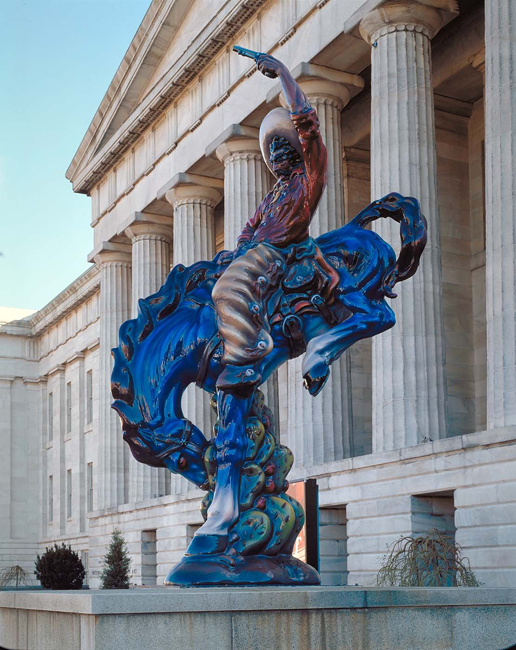
After twenty-five years as the director of the Gallery at UTA, Huerta had recently stepped down and wanted this exhibition to bookend his tenure there. “It’s coming to full circle, so to speak,” he told me.
“I think his work is very passionate,” Huerta says, extolling Jiménez’s depictions of everyday people and Chicano culture. However, Huerta feels that as a result of his premature death and contingencies with the estate, that “Luis’s work, as a result, has not gotten the kind of attention that was beginning to build.”
Rees concurs: “Once he died, it became a lot trickier.”
Both curators, however, expressed optimism that a major exhibition may be in the pipeline at the Nasher Sculpture Center in Dallas (the museum says they can’t yet announce anything about exhibitions in the years ahead). An exhibition like that at a major museum could really open up appreciation for Jiménez’s work at a time when his political sensibilities, sharp social commentary, and incisive views of the construction of the West, as seen in his Progress Suite, feel especially relevant.
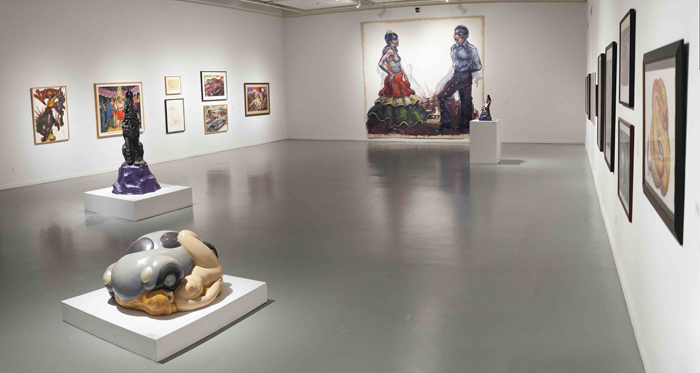
Over the weekend, I participated in the 2023 Texas Sculpture Symposium at Texas Tech University. I related to some of the attendees that I was writing this article and was in turn regaled with memories and stories—some quite fantastic and unbelievable—about Jiménez, his outsized presence, his influence, and his legacy in this region.
“I think the appreciation for him is still wide open and will take hold in a wider way once a [major] museum… is able to do a retrospective… and then everyone would know his name, and they should,” Rees says. “[His work] is exactly right for right now, for a thousand reasons,” she adds, emphatically. “I think he’s one of the most important artists that America has ever churned out, frankly.”
Life and Death: Luis Jiménez continues at the Gallery at UTA, University of Texas at Arlington, through April 1, 2023.
